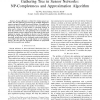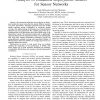468 search results - page 41 / 94 » Energy Model for H2S Monitoring Wireless Sensor Network |
INFOCOM
2008
IEEE
14 years 2 months ago
2008
IEEE
Abstract—Energy efficiency is critical for wireless sensor networks. The data gathering process must be carefully designed to conserve energy and extend the network lifetime. Fo...
VTC
2010
IEEE
13 years 6 months ago
2010
IEEE
Abstract—We present the estimation and evaluation of deployment models for sensor networks that exploit different amounts of a priori information. Topologies generated from the m...
DATE
2010
IEEE
14 years 21 days ago
2010
IEEE
— The task scheduler of an energy harvesting wireless sensor node (WSN) must adapt the task complexity and maximize the accuracy of the tasks within the constraint of limited ene...
SAC
2005
ACM
14 years 1 months ago
2005
ACM
Wireless Sensor Networks (WSNs) are distributed systems whose main goal is to collect and deliver data to applications. This paper proposes a reflective, service-oriented middlewa...
LCN
2003
IEEE
14 years 27 days ago
2003
IEEE
A wireless sensor network is a special kind of ad-hoc network with distributed sensing and processing capability that can be used in a wide range of applications, such as environm...



